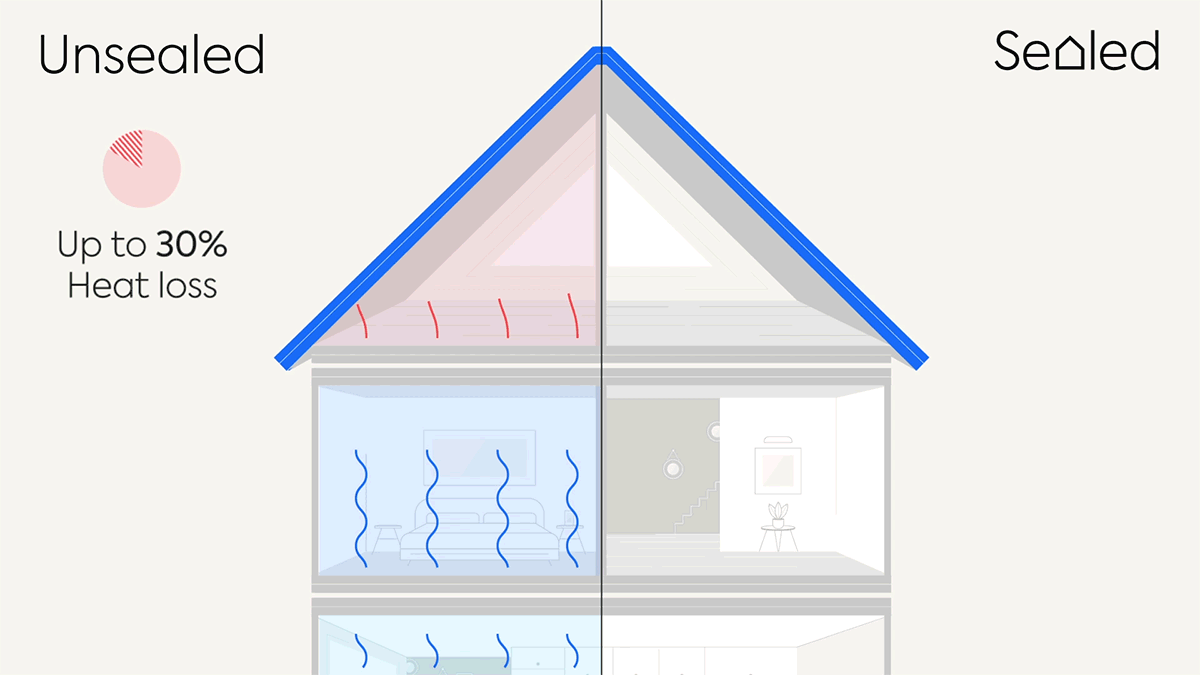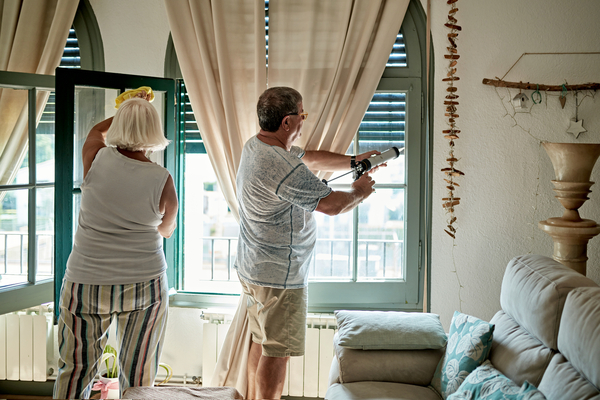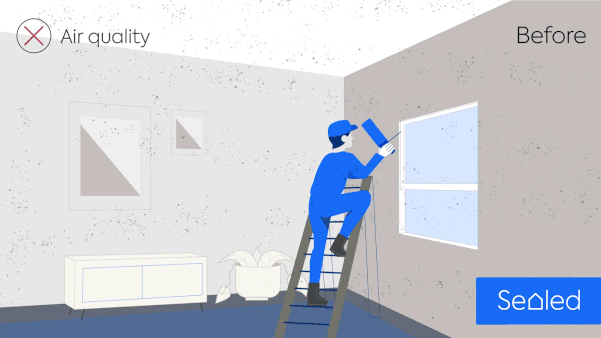Got chills? Your house doesn’t have to be this way. Read on to learn how to get your windows to leak less heat.
Are you here asking yourself How do I stop drafty windows? Installing new windows can be expensive, but there are cost-effective solutions that stop drafty windows in their tracks—and save you from wasting energy.
Here’s some great news: You can fix window drafts without replacing all the windows in your house.
(Was that a sigh of relief we just heard?)
Even better news? With Sealed, you can eliminate drafts with an energy-savings guarantee if your house qualifies. Discover how.
Fixing drafty windows will help you save money on utility bills and make your home more comfortable year round. So let’s get started…
In this guide you’ll cover:
- What causes drafty windows in the first place
- Why you shouldn’t necessarily replace your drafty windows with new ones
- How to fix drafty windows (both permanent and temporary fixes)
- How you can stop window drafts by sealing leaky windows
- How to get the permanent fix for a drafty windows (and a drafty house) with an energy-savings guarantee)
Key points:
- Even if you installed beautiful, brand-new energy-efficient windows tomorrow, it’s likely that you’ll still have drafts—and we’ll explain why.
- Drafty windows are signs of energy waste. They also directly contribute to home air quality problems, because they allow excess allergens and moisture into your house.
- Fixing drafty windows permanently involves a whole-house solution, which we’ll detail in this guide. They’re not a problem to be overlooked, but the bright side is that they’re fixable—and weatherization rebates and energy upgrade programs (like Sealed!) make the project hassle free and more affordable.
What causes drafty windows?
Before you can stop window drafts, you need to know what causes them in the first place.

The short answer? Air leaks.
Air leaks are the tiny cracks and seams in your home that can cause drafty windows and doors, moisture issues, and unwanted air exchange. This means heat loss in winter and heat gain in summer—making your home uncomfortable year round.
Every home has air leaks—they form as houses settle over time (this even happens in new construction). You can’t see air leaks, but you sure can feel them.
Actually, maybe you can see them… when they show up on your energy bill each month. Air leaks cause your HVAC to run constantly as it tries to compensate for your drafty house (making your energy costs skyrocket).
How do small air leaks cause such big drafts (and even bigger energy waste)?
It’s called the stack effect, and it’s how air moves through your home. You can think of it like a giant vacuum.
As heat rises through your house and escapes through the attic (usually due to inadequate insulation and air leaks), outside air rushes in through all the tiny holes in your house to fill the void the escaping indoor air left behind.
This causes high heating costs in winter and big cooling bills in the summer, so it feels like you’re literally paying to heat and cool the outdoors.
Check out the video below for a quick visual explanation.
The stack effect isn’t limited to just your drafty windows.
Anywhere gaps are present will cause unwanted air exchange. Exterior doors, plumbing and electrical fixtures, your fireplace, cables, light fixtures, the foundation of your house, ductwork, and your attic are all common culprits for air leaks.
Stop losing heat at no upfront cost—find out how.
Home air leaks account for up to 40% of the energy wasted for heating and cooling your home.
ENERGYSTAR.gov
Why you should fix your drafty windows instead of replacing them
Many homeowners assume that drafty windows can only be resolved by installing new windows. (Not true!)
Why? Well, your windows aren’t the problem.
So even if your house has old single-pane windows, replacing them with brand-new double-pane windows with a “lifetime warranty” won’t fix the primary issues that are causing drafts and discomfort in your house.
(Really… don’t fall for it—especially if a FREE! set of ginsu knives comes with the offer.)
Seriously though, new windows are a beautiful upgrade, but the best windows on the market can’t stop drafts because the air leaks are not in the window glass itself. They’re around the window frames—and in and around a number of other unseen places throughout your home.
Air leaks are a whole-house problem, but thankfully, there is a whole-house solution.
To permanently stop unwanted airflow in your home, you’ll need professional air sealing and insulation upgrades.
(And Sealed can help you get the work done with zero upfront cost. Learn how.)
Air leaks are a whole-house problem, but thankfully, Sealed has a whole-house solution.
How to fix drafty windows (4 alternatives to replacing them)
Remember, it’s a myth that replacing your windows will automatically stop drafts. A drafty house has underlying issues that need the right fixes.
The first alternative includes temporary solutions—ideal for renters—and the last three solutions cover long-term fixes that will help stop drafts for good.
Consider these four effective alternatives to installing new windows:
- Installing thermal curtains, draft-stoppers, or weatherstripping
- Insulating old windows
- Air sealing your windows
- Whole-house insulation and air sealing
We’ll explore the temporary alternatives first, then delve into the permanent home improvement upgrades that will have a lasting impact on your home’s comfort and energy savings.

Check out our FREE home energy-efficiency guide to learn how 3 core efficiency upgrades can make your home more comfortable year round.
Learn exactly why new windows aren’t the answer. Get the guide.
Temporary fixes: How to fix drafty windows in a rental property (or fast solutions for homeowners)
What if you’re in a rental or are a homeowner who needs a quick temporary fix right now to make your home more comfortable?
No worries. If you need a to stop drafty windows today, you have options:
- Hang thermal curtains and blinds. Window coverings can serve as extra insulation around windows to reduce drafts. Tap here for an in-depth look at whether thermal curtains really work and how to install them.
- Use homemade draft stoppers. Making a “draft snake” for gaps around windows and exterior doors can reduce icy-cold air from getting in. Check out this short DIY video for making draft stoppers with recycled plastic bags.
- Upgrade your weatherstripping. If the weatherstripping around your windows and doors is looking worse for the wear, installing new weatherstripping can help with draft reduction.
Temporary solutions like these will help your home feel cozier, but they won’t fix the other issues that put a chill in the air (kinda like wearing a scarf but forgetting your winter coat, hat, socks, and gloves!).
So let’s dig in to some long-term solutions to fix your drafty windows.
Long-term fixes: How to fix drafty windows
Homeowners who aren’t satisfied with temporary, bandage solutions for drafty windows have two primary options:
Insulating windows
Insulating windows simply means applying an extra layer of material to reduce heat transfer through the window glass.
(Technically, hanging thermal window coverings is a way to partially insulate windows, but like the other temporary fixes we mentioned above, they don’t stop window drafts.)
Adding window insulation can help minimize heat transfer, especially if you have older, single-pane windows. But this solution will be most effective when paired with professional air sealing and insulation.
How to insulate a drafty window
With a quick trip to the hardware store, you can have better-insulated windows in no time by installing custom-fitted window inserts or interior storm window inserts. These interior window add-ons can provide an extra layer of insulation for single-paned windows without blocking any views.
Unfortunately, both options won’t stop air leaks along the edges of your window where it’s inset into the wall of your home. (We’ll cover that in the air sealing section below!)
Did you notice that we didn’t mention plastic window film insulation kits? (You know the ones—they include plastic sheets of shrink wrap, and you use a hair dryer and double-sided tape to adhere them to the window glass.)
Many homeowners have used window insulation film for years, but as it turns out, putting plastic wrap over windows has a very low insulation rating (1). Tap here to discover why plastic window insulation kits aren’t the best choice.
You’d actually be better off using window coverings or the make-a-snake options than putting plastic film on your windows. But—like adding insulation to the glass—bandage solutions won’t permanently fix drafty windows.
Whole-house insulation is a better long-term option for stopping air leaks throughout your home so your home is comfortable year round.
How insulating your house properly can help stop window drafts
A well-insulated home reduces the stack effect so you can enjoy even temperatures in your home.
Not sure whether your current insulation is doing the job?
According to ENERGY STAR, attics need 10 to 14 inches of insulation (2). If you haven’t had your insulation assessed by a professional in 10 years, it’s probably time.
Insulation wears down over time affecting the thermal boundary between your house and outside temperatures and increasing the risk of heat escape through your attic and roof.
Fun fact: Homeowners recover up to 84% of the cost of an insulation upgrade at resale.
NAR
The permanent fix to stop drafts: Have your home insulated by people who know what they’re doing
A professional home performance contractor can determine whether your home has sufficient insulation or if heat is escaping through the roof (hello, energy waste!).
If you need more insulation, they can help you select some with the right r-value that will work with the existing insulation throughout your home.
That way, you’re treating your drafty window problem at the root—and with the right solutions that can eliminate drafts for good.
Air sealing windows
Air sealing is the act of carefully detecting air leaks and closing them up with caulk, insulation, or other heat-escape barriers.
For the purposes of this guide, we’ll discuss air sealing windows specifically. But to truly stop drafts in your home, you need air sealing in other areas as well—not just around your windows.
(Read our Guide to Air Sealing to learn more about the importance of sealing other areas of your home.)

You could cut up to 45% of your energy waste in your home with the right air sealing and insulation upgrades.
2022 Insulation Industry Opportunity Study
How to seal windows to stop cold air drafts for good
Before you get started, you may want to read How to find air leaks in your home to make sure air sealing is the kind of project you want to tackle alone.
Depending on the age of your windows and what they’re made of, the steps to sealing windows can be fairly straightforward:
- Examine your windows. Find the seams and gaps around your windows—both the interior and exterior. Locate the weep holes (they need to stay open). And determine whether your glass needs reglazing.
- Purchase your materials. Caulk and window glazing compounds are fairly inexpensive and can be purchased at any home improvement store. Consider your caulking options: Do you need both interior and exterior caulk? Do you have interior bathroom windows that need waterproof caulk? Will an interior-exterior combo emit too many fumes inside your home?
- Glaze your windows. Reglazing windows is highly technical work, as it requires removing the old glass panes from the window frames. If you plan on reglazing, we recommend doing this step before you caulk. (Watch this quick video to see the basics of reglazing a single-pane window.)
- Caulk all air leaks. Achieving an even and smooth line of caulk to seal windows can be tricky. It takes patience and a steady hand. (It also helps to pay attention so you don’t caulk the window shut. Really, it happens.) And, as we mentioned above, certainly avoid sealing the weep holes. Weep holes allow moisture to drain away from your windows—don’t block these, or you could cause permanent damage to your windows.
- Call the professionals. When in doubt, get professional help. Fixing drafty windows is difficult work—not to mention time consuming. And sealing your windows incorrectly could cause damage, so it’s a job best left to the pros if you’re feeling unsure about how to do it yourself.
I highly recommend [Sealed]! The installers were friendly, professional, answered my million questions, and really knew their job!
Laurie S., Sealed customer
The permanent fix: Why you need to air seal your whole house to stop window drafts
Adding caulk to close up open seams around your windows is something many homeowners are comfortable doing.
But even if you are careful to seal your windows correctly (go you!), open seams, gaps, and cracks throughout your house are still causing drafts.
So unfortunately, even with newly sealed windows your home still won’t be draft-free unless you air seal other parts of your home, too.
Even with newly sealed windows your home still won’t be draft-free unless you air seal other parts of your home, too.
Professionally air sealing your whole home is the way to stop drafts permanently.
When you permanently fix drafty windows with professional air sealing and insulation, you’ll also reduce your energy usage, increase your home’s indoor air quality, and make your home feel amazing year round.

Sealed’s full-system approach to stopping home energy waste has a proven track record: We’ve shown that we can reduce a home’s energy use by up to 50%.
Stop drafty windows for good—with an energy-savings guarantee
Fixing drafty windows can be a challenging project—one that can leave you with continued drafts if the rest of your home hasn’t been professionally sealed and insulated.
But if your home qualifies, you can get professional home insulation and air sealing (including sealing and insulating your old windows!) with an energy-savings guarantee and flexible payment options with Sealed—eligible rebates included.
The best part about working with Sealed?
We manage the entire project for you, negotiate costs on your behalf, hire local expert contractors, and stay accountable to the work being done right.
It’s the hassle-free way to make your home more comfortable and energy-efficient—and stop drafty windows once and for all.